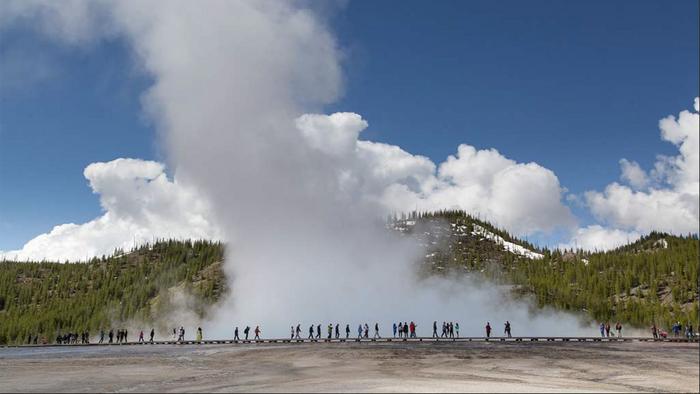People depend on natural ecosystems of trees, grasses and shrubs to capture carbon from the atmosphere and pull it underground to slow the decline toward climate-change disaster. Ironically, these same protected spaces also tend to be highly photogenic hot-spots for tourism.

Credit: National Park Service
People depend on natural ecosystems of trees, grasses and shrubs to capture carbon from the atmosphere and pull it underground to slow the decline toward climate-change disaster. Ironically, these same protected spaces also tend to be highly photogenic hot-spots for tourism.
New research from the Quinney College of Natural Resources and the Institute of Outdoor Recreation and Tourism makes a case study of one such place — Yellowstone National Park — to calculate surplus carbon visitors from across the world add to the atmosphere each year as a direct result of a park visit.
Emily Wilkins and Jordan Smith from the Department of Environment and Society and colleagues leveraged existing data to create a tally of carbon emissions generated by one year of tourist visits to Yellowstone National Park, a popular destination that can receive over 4 million visitors per year. They estimated that recreation visits to the park produce just over one megaton of carbon emissions per year, an average of 479 kilograms attributable to each visitor (about the weight of a grand piano).
The bulk of those emissions occur before a visitor even spies a geyser or a wandering wolf pack. Travel to and from the park entrance accounts for almost 90 percent of the total. Another 5 percent is produced as visitors move from place to place within park boundaries and four percent is sourced in overnight accommodations. Just 1 percent of the total comes from park operations such as visitor centers, museums, shops and restaurants.
Just over one-third of visits to Yellowstone involve someone taking a flight, but those particular trips accounted for a whopping 72 percent of the emissions for out-of-park transit.
“As the tourism industry explores strategies to reduce their carbon impact, this could be low-hanging fruit,” said Wilkins, who now works with the U.S. Geological Survey. “Future campaigns to encourage a greater proportion of visitors from nearby locations rather than Europe or Asia, or encouraging driving over flying, have potential for big impacts on reducing these emission numbers.”
But it seems that carbon accounting for Yellowstone National Park is still in the black.
“Interestingly, ecosystems within the park boundary pull around 1.5 megatons of carbon from the atmosphere each year,” Smith said. “So, even accounting for the significant impact of tourism, there is a net benefit in the system as a carbon sink.”
This is almost certainly not the case for smaller parks with high visitation numbers, he said.
This new method for calculating the carbon impact of tourism for national parks is designed to be adaptable for application to other parks and protected areas, Smith said, to help decision makers evaluate the effectiveness of potential emission reduction strategies.
Tourism is no lightweight player in the world’s total carbon tally. By one account, tourism accounted for 8 percent of annual global carbon emissions, with the U.S. earning the dubious honor of the highest total tourism carbon footprint in the world. And that number is expected to grow.
It’s important to note that this research was not a comprehensive policy analysis, according to the authors. Ecotourism has other costs and benefits that weren’t under consideration in this particular research. For example, while tourism does contribute significantly to carbon emissions globally, positive experiences and education at parks like Yellowstone have potential to lead to indirect environmental benefits, such as encouraging pro-environmental behaviors back at home.
“We really need more research on both the effect of tourism on climate change, and the effect of climate change on tourism,” Wilkins said. “These topics both have major economic and environmental repercussions. Managers and decision makers need a more complete perspective for how tourism to parks is contributing to a vulnerable global climate system.”
Journal
PLOS Climate
Method of Research
Case study
Subject of Research
Not applicable
Article Title
Quantifying and evaluating strategies to decrease carbon dioxide emissions generated from tourism to Yellowstone National Park
Article Publication Date
3-Apr-2024



